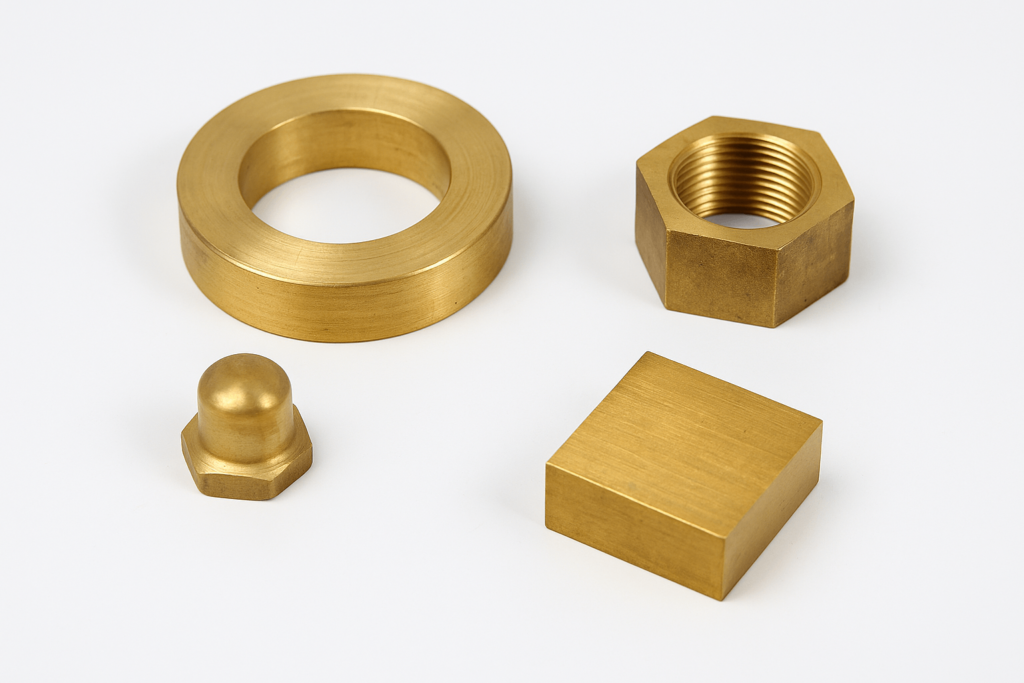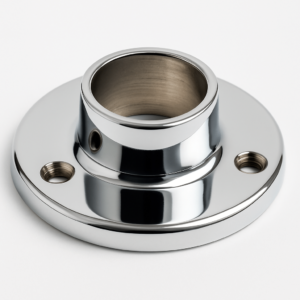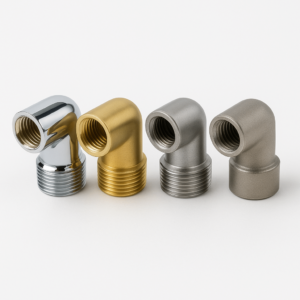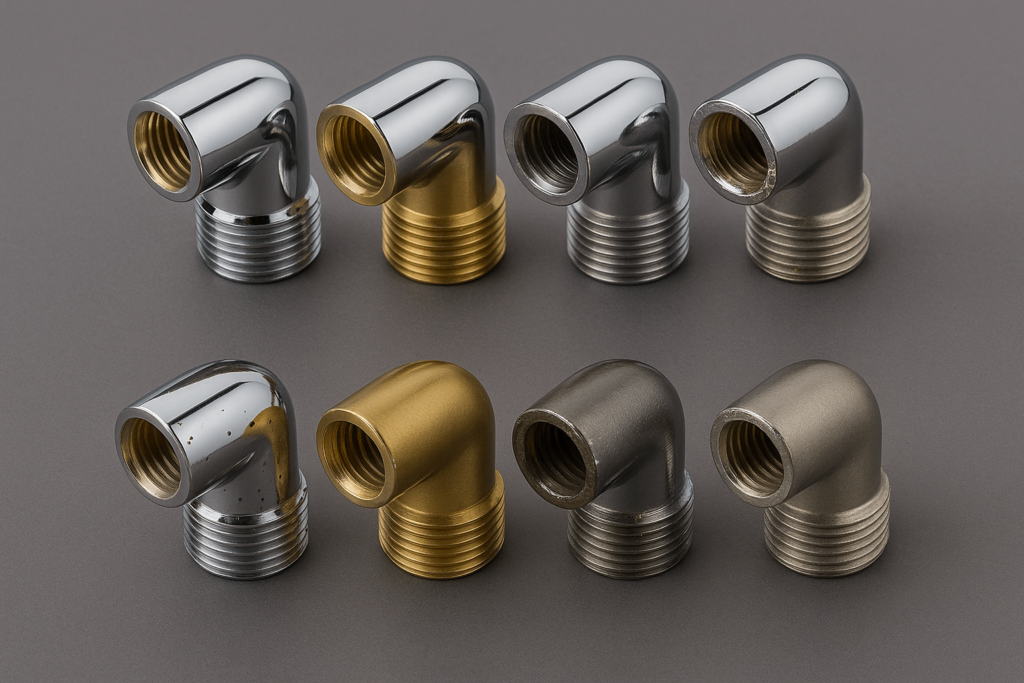Introduction: The Science Behind a Reliable Supply Chain
For procurement managers and wholesale buyers, the brilliant chrome finish on a component represents more than aesthetics; it signifies a promise of quality and performance.
Whether sourcing plumbing fixtures, automotive chrome plating components, or architectural hardware, the reliability of that finish directly impacts your brand’s reputation and bottom line. A premature failure is not just a defective chrome part—it’s a costly return and a disruption to your supply chain.
This guide deconstructs the chrome plated material from a manufacturer’s perspective. We will move beyond marketing claims to explore the critical process controls, material science, and industry standards that define a truly superior product—empowering you to make confident procurement decisions when selecting a trusted chrome plated brass supplier.
Chapter I: The Anatomy of a High-Performance Finish: Deconstructing the Core Layers
To confidently source chrome plated brass, one must understand its fundamental structure. A high-performance chrome coating is an assembly of distinct layers, each with a specific engineering function. The failure of one layer compromises the entire system.
1.1 The Foundation: Why Brass Alloy Selection is a Critical First Step
The manufacturing journey begins with selecting the brass substrate for plating. Brass, an alloy of copper and zinc, is preferred due to its corrosion resistance, high conductivity, and ability to be shaped into complex geometries with precision.
Specifying the right alloy is a critical responsibility for procurement professionals. When it comes to stamped components, C26000 Cartridge Brass offers excellent ductility. In contrast, C36000 Free-Cutting Brass is globally preferred for high-speed CNC-machined parts due to its superior machinability and finish quality.
This introduces a critical specification trade-off: machinability versus safety. C36000 contains lead, rendering it unsuitable for potable water. Regulations such as the U.S. “Get the Lead Out” act mandate “lead-free” components for drinking water applications.
Thus, components used in drinking systems must utilize certified lead-free brass, carrying NSF/ANSI 61 & 372 certification. Verifying this compliance is a non-negotiable procurement responsibility. You can verify approved products through the NSF Certification Directory.

1.2 The Powerhouse: The Nickel Underlayer—The Core of Durability
While chromium offers the iconic look, the true workhorse is the nickel undercoat for chrome plating. This layer is key to both corrosion resistance and visual brilliance.
For demanding applications like automotive chrome plating, a duplex nickel plating system is recommended. It combines a semi-bright nickel base with a bright nickel layer on top.
Bright nickel is electrochemically active. When corrosion occurs, a microscopic galvanic cell forms. The bright nickel layer functions as a sacrificial anode, corroding first to protect underlying layers. This slows vertical pitting and encourages lateral corrosion, greatly extending product life.
1.3 The Ultimate Shield: The Hard, Tarnish-Proof Chromium Topcoat
The outermost layer, the chromium topcoat, though thin, is critical. With a hardness of 65–69 HRC, it shields against scratches, wear, and environmental tarnish.
This chrome material is also chemically inert, maintaining its brilliance throughout the product lifecycle. Suppliers offering custom chrome plating services should guarantee consistent thickness in this layer. Buyers searching for a reliable OEM chrome plating factory should request coating thickness test reports to verify quality.

Chapter II: From Raw Metal to Mirror Shine: A Manufacturer’s Perspective on Process Control
Understanding the layered structure is important, but knowing the chroming process helps gauge supplier quality. The chrome electroplating process involves a precise sequence where any deviation can lead to failure.
2.1 The “90% Rule”: Why Flawless Preparation is a Non-Negotiable Quality Gate
In finishing, 90% of quality is determined before plating begins. Brass surface preparation for plating is thus the most critical stage. Skipping this step compromises long-term performance.
The process starts with mechanical polishing to remove defects, followed by alkaline electrocleaning to eliminate residues. A multi-stage rinse leads to an acid activation bath, removing oxides and priming the surface for a strong bond. Errors here result in delayed issues like peeling or blistering.
2.2 The Electrochemical Ballet: A Symphony of Controlled Deposition
With the brass substrate ready, chromium electroplating begins. The part, as the cathode, moves through electrochemical baths.
An optional copper strike may be applied to enhance adhesion. Then, it undergoes nickel plating, followed by immersion in the chrome plating solution. Chromium ions deposit onto the nickel under precise electrical and chemical controls, ensuring consistent coating quality. A qualified custom chrome plated parts manufacturer will monitor these parameters continuously.
2.3 Designing for Plating to Mitigate the “Faraday Cage Effect”
A key challenge in chrome electroplating is the Faraday cage effect, where current bypasses recessed areas.
Partnering with experienced manufacturers can mitigate this. Design guidelines include:
- Use generous radii on corners.
- Avoid deep recesses or blind holes.
- Favor through-holes where possible.
These steps support uniform plating and minimize defects.
Chapter III: Performance Deep Dive: Translating Technical Data into Business Value
Understanding performance metrics transforms chrome plated metal from a commodity to a strategic material.
3.1 The Hardness Specification: Distinguishing Decorative vs. Industrial Hard Chrome
“Hard chrome” often causes confusion. Though decorative chrome reaches 65–69 HRC, it differs from industrial hard chrome.
- Decorative Chrome: Thin (0.13–0.5 µm), for aesthetics and light-duty protection.
- Industrial Hard Chrome: Thick (20–200+ µm), used in engineering with 800–1200 HV hardness.
Understanding the hard chrome vs decorative chrome distinction ensures appropriate material selection.
3.2 The Corrosion Shield’s Reality: What “1000 Hours Salt Spray Test” Results Really Mean
ASTM B117 is the benchmark chrome plating salt spray test. A top-tier chrome finish can endure over 1000 hours. You can review the standard from the ASTM B117 official page.
However, this test is better suited for quality comparison than lifespan prediction. The key to superior ASTM B117 corrosion resistance lies in microdiscontinuous chromium—engineered with microscopic pores to diffuse corrosion and slow degradation.
3.3 The Critical Safety Standard: Ensuring Compliance for Potable Water Applications
In plumbing, safety is paramount. The question is chrome plated brass safe for drinking water hinges on certification.
Only components meeting NSF/ANSI 61 and 372 are truly safe. Procurement must confirm that NSF 61 certified brass fittings are used to ensure compliance and reduce risk.
Chapter IV: The Material Selection Matrix: Chrome Plated Brass vs. The Alternatives
Material decisions affect cost, performance, and longevity. Understanding how chromed metal compares to alternatives empowers informed decisions.
| Material/Finish | Aesthetics & Finish Consistency | Durability/Hardness | Corrosion Resistance | Relative Cost (TCO) | Environmental Compliance |
|---|---|---|---|---|---|
| Chrome Plated Brass | ★★★★★ | ★★★★☆ | ★★★★☆ | ★★★☆☆ | ★★☆☆☆ (Hex) / ★★★★☆ (Tri) |
| Solid Stainless Steel | ★★★★☆ | ★★★★☆ | ★★★★★ | ★★☆☆☆ | ★★★★★ |
| PVD Coating on Brass | ★★★★★ | ★★★★★ | ★★★★★ | ★★☆☆☆ | ★★★★★ |
| Nickel Plated Brass | ★★★☆☆ | ★★★☆☆ | ★★★☆☆ | ★★★★☆ | ★★★☆☆ |

Chapter V: The Procurement Toolkit: How to Qualify Suppliers and Verify Quality
Knowing how to check chrome plating quality is essential for consistent sourcing. This toolkit equips you with verification steps.
5.1 The Initial Check: The Magnet Test
Brass is non-magnetic. A magnet sticking to a chrome plated brass part likely indicates steel—a different substrate with different corrosion traits.
5.2 The Expert’s Eye: Visual Inspection for Process Flaws
Inspect samples for:
- Pitting: Small surface pinholes.
- Blistering/Peeling: Sign of adhesion failure.
- Cloudiness: Non-uniform luster.
- Uneven Coverage: Inconsistent coating in recesses.

5.3 The Professional’s Mandate: Demand the Specification Sheet
Visual checks aren’t enough. Require spec sheets referencing ASTM B456, covering coating thickness and nickel layer structure. A supplier’s ability to provide documentation signals strong quality systems.
Chapter VI: The Future is Green (and Regulated): Navigating Global Compliance
Regulations are reshaping the future of chrome plating. Compliance is vital for global trade.
6.1 The Great Shift: From Hexavalent (Cr⁶⁺) to Trivalent (Cr³⁺) Chrome
Traditional chroming service uses hexavalent chromium (Cr⁶⁺)—effective but highly toxic.
The industry is transitioning to trivalent chromium (Cr³⁺)—safer and more eco-friendly. Key regulatory drivers:
- RoHS: Limits Cr⁶⁺ to 0.1% in electronics.
- REACH: Flags Cr⁶⁺ as SVHC, requiring special use authorization.
| Feature | Hexavalent Chromium (Cr⁶⁺) | Trivalent Chromium (Cr³⁺) |
|---|---|---|
| Toxicity / Safety | Carcinogenic, high toxicity | ~500x less toxic |
| Environmental Impact | Hazardous waste, complex disposal | Easier treatment, lower impact |
| Color / Appearance | Bright silver, bluish hue | Close match to hex chrome |
| Process Control | Wide operating range | Tighter controls required |
| Regulatory Status | Strictly limited | Fully compliant and preferred |
Conclusion: More Than a Mirror Finish, A Commitment to Manufacturing Excellence
For wholesale buyers, chrome plated brass represents engineered precision. Quality stems from material choice, layer synergy, and process control.
Knowledge of the science behind it equips professionals to go beyond appearance—choosing suppliers who prioritize enduring quality.
FAQ (Frequently Asked Questions for Procurement Professionals)
- What is the lifespan of chrome plated brass in commercial use? Up to 15–20 years when properly specified. Chrome finish can extend part life severalfold.
- Chrome vs. stainless steel for plumbing?
Chrome plated brassallows intricate designs and lower costs.Stainless steeloffers unmatched corrosion resistance in extreme environments. - Does chrome plated brass rust? No—it doesn’t rust (no iron). Damage to plating can expose brass, which may corrode under severe conditions.
- How to tell chrome from nickel plating? Chrome has a cool bluish-silver hue; nickel appears warmer and yellowish. Chrome is harder and more scratch-resistant.

